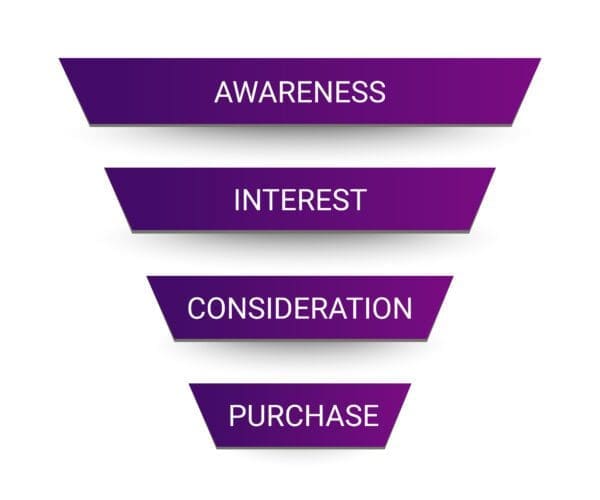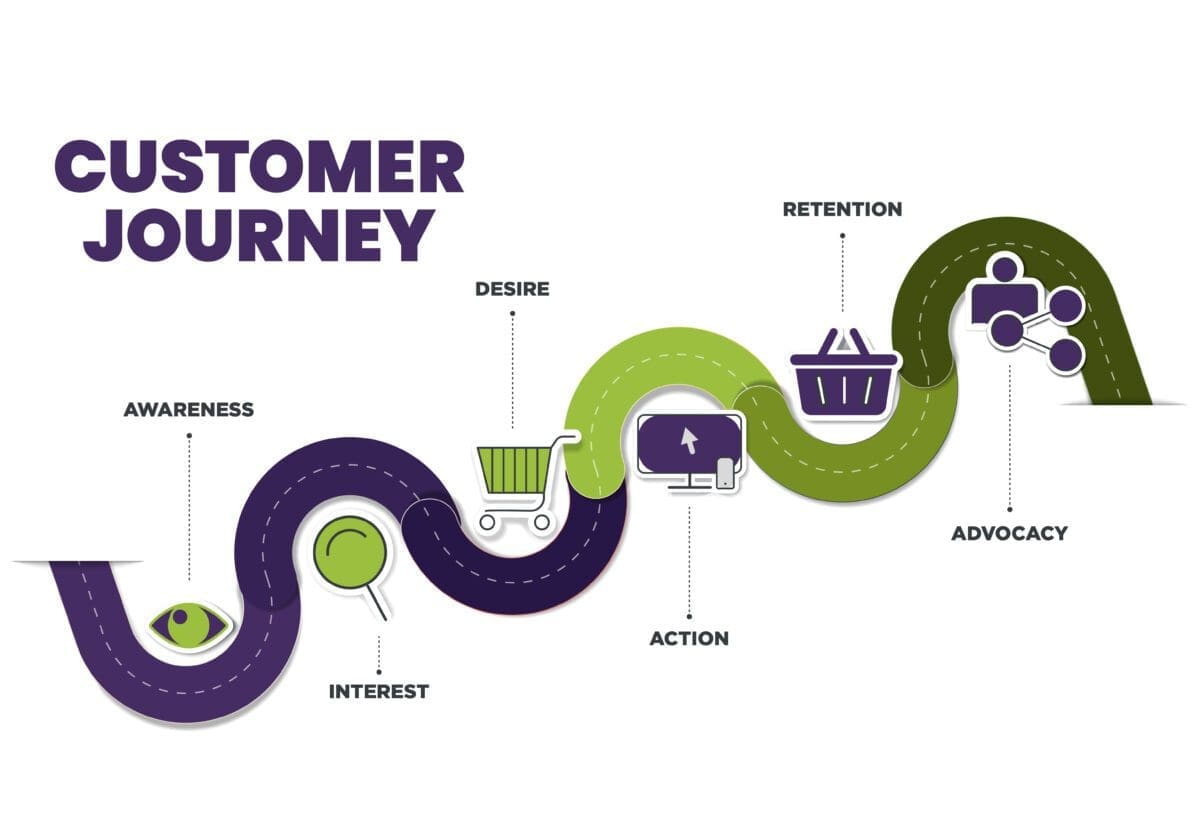Published: February 14, 2023
In the world of marketing, there is often great debate over what marketing strategies are the most effective. The truth is there is no one size fits all strategy in marketing. Ultimately, you must decide what marketing strategy will best help your business succeed. In a sea of marketing strategies, two methodologies stand out, the customer journey and the sales funnel.
As you develop an effective marketing strategy for your business, understanding the differences between the two is crucial.
The Sales Funnel
A sales funnel is a traditional marketing concept that outlines the steps a customer takes from awareness to purchase.
It typically consists of four stages: awareness, interest, consideration and purchase. The focus of a sales funnel is to ultimately convert a prospect into a customer and make a sale.

- Awareness: a prospect is introduced to the brand and discovers a problem they didn’t know they had.
- Interest: the prospect actively seeks a solution and researches the brand and its offerings.
- Consideration: the prospect is ready to make a decision and considers the brand as an option.
- Purchase: the prospect has made a decision and is prepared to purchase.
Throughout each phase of the funnel, businesses need to engage with potential customers to provide them with the information and support they need to make an informed purchase decision.
This can be achieved through various marketing and sales tactics, such as digital advertising and email marketing. By understanding and optimizing each stage of the funnel, businesses can drive more conversions, increase revenue and grow their business.
The sales funnel simplifies and streamlines the process of acquiring customers and gaining conversions.
It is easy to track and measure progress as prospects travel down the funnel; however, there are some drawbacks to be mindful of. The sales funnel often does not entirely consider and capture the user experience. Instead, it can function as a one size fits all marketing approach and may cause your business to miss out on cultivating a connection with a potentially loyal customer base.
The Customer Journey
A customer journey is a more comprehensive view of the entire customer experience. It encompasses the phases of a sales funnel and goes beyond that to include what happens after a customer makes a purchase. A customer journey considers all customer interactions with a brand, including multiple touchpoints such as customer service, email marketing and social media.
It provides a complete picture of the customer’s journey, from their initial encounter with the brand to their experience as a loyal customer. Understanding the customer journey is integral to creating a seamless and memorable experience for your customers.
Where to start?
To create a successful customer journey, it’s essential to understand your target audience and their needs. Start by asking questions such as:
- What are their pain points?
- What are their goals?
- What motivates them?
- What are their behaviors and habits?
The Customer Journey Map
Once you understand your target audience, you can map out their journey and identify potential roadblocks. This map can provide a visual representation of every step, from awareness to brand loyalty and can help guide your business in making decisions with your customer in mind.
You can also create personas, which are fictional characters that represent your target audience, to help you better understand your customer’s needs and better tailor their experience.

Some common stages in a customer’s journey include:
- Awareness: a prospect becomes aware of your brand, product or service.
- Interest: the prospect starts to research and consider your offerings.
- Desire: the customer wants what you have to offer.
- Action: the customer makes a purchase or takes another action.
- Retention: the customer continues to engage with your brand and becomes a repeat customer.
- Advocacy: the customer becomes a mini brand ambassador and tells their friends and family about your products.
Oftentimes a customer’s journey is not linear. If brand familiarity and trust are already established, a customer may be ready to purchase right away.
In the wild
Currently, we are seeing a lot of this through influencer marketing on social media. Consumers who trust an influencer will purchase something because of the trust built with that person, enabling them to purchase without completing the full journey. With TikTok, a beauty product can go from unknown to sold out overnight. If a beauty influencer with a large following gives a product a positive review and recommends it to their followers, you can all but guarantee sales will skyrocket. Customers that are influenced are willing to buy blind because of the trust that the influencer has built with their base.
We can learn a lot from observing a customer’s journey as it allows for more data collection points. We can gain valuable insights into where customers may drop off or need additional support on their way. As we keep an eye on their journey, there are more opportunities to create a personalized experience for each customer.
But like anything else, the customer journey comes with drawbacks too. It can be time-consuming and tedious to map out, automation becomes more difficult and gaining data and analytics to enhance user experience can be expensive. However, drawbacks aside, with this strategy, the pros outweigh the cons.
Long live the Customer Journey
Now that we’ve looked at the traditional sales funnel and the customer journey, it’s safe to say that one outshines the other. As marketers, we must stay agile and evolve with our ever-changing industry.
The truth is that traditional sales funnels just don’t cut it anymore. We’ve found that customers can tell when they are just another sale and are put off by cold and outdated marketing tactics. The customer journey contains the most important elements of the sales funnel but makes it more like a marketing sandwich, made up of sales tactics and feel-good elements for the customer.
Customers today want to be a part of a community, to be proud of the products they’re purchasing and to feel like their experience matters. But that’s good news for your business!
While establishing trust with a customer can be a delicate dance that doesn’t happen overnight, a loyal customer means repeat purchases and word-of-mouth marketing, which can be 5x more effective than traditional marketing efforts.
Final thoughts: How to bring your Customer Journey to life!
We know how complicated creating a successful customer journey map can be, but that’s where we come in!
Our experts specialize in building customer journeys that drive conversions and build a loyal base of customers for your business. Ready to start on your path to reaching your marketing goals? Let’s chat!
